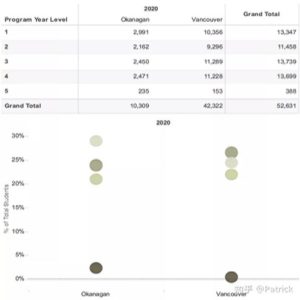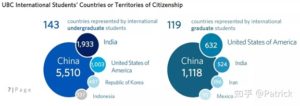The latest admission data on Canadian universities
1. University admission data in Ontario
As of June 2021, Ontario universities have received 706,119 applications (470,000+ Canadian students, 220,000+ international students), 28,655 more than last year. In 2020, due to the epidemic, the number of applications for universities in Ontario decreased by 10,628 compared with the previous year (2019). This is also the first time the number of applications has declined in the past 6 years (2015-2020). The surge in applications this year means that the trend of studying abroad has finally returned!
The top 5 popular universities in Ontario for international students are as follows:
1) University of Toronto: 50,940 applications
2) University of Ottawa: 27,394 applications
3) University of Waterloo: 21,794 applications
4) McMaster University: 20,019 applications
5) University of Western Ontario: 18,024 applications
In Canada, the largest demographic of international students is Indian, with second place being Chinese. At the University of Toronto, the number of Chinese international students far exceeds that of other countries. Among them, Chinese undergraduates studying abroad accounted for 64.9% of international undergraduate students, and Chinese postgraduates students accounted for 42.9% of international postgraduate students.
The 5 most popular university majors for international students
The data shows that the top five majors studied by international students are: Business, Social Sciences, Engineering, Humanities and Biological Sciences.
The 5 most popular university majors for domestic students
Most domestic students study the following five majors, but the ranking order is slightly different: Business, Biological Sciences, Social Sciences, Engineering and Humanities.
2. B.C. university admission data
(1)University of British Columbia (UBC)
The following figure shows the overall data of UBC in the past 12 years. From the blue undergraduate line, it can be seen that the student growth is very linear, while the enrollment of graduate students is relatively conservative. The number of graduate students in 2020 is only more than that what it was in 2009: 1361 people. It also confirms the fact that it is difficult to apply to be admitted as a UBC graduate student.
As for undergraduate students, the number of admissions for Fall 2020 is still higher than that for Fall 2019, an increase of about 3%. It can be seen that the number of students in the school has not declined due to the impact of COVID-19.
According to UBC international student data, the total number of international students in the school is 17,918, accounting for about 25.6% of the whole school. This proportion of international students is considered to be an average proportion among Canadian universities. However, many people feel that UBC is very Asian, but most of these Asians are early immigrants with Canadian status, so we often say the 'C' in UBC stands for China, which is not as accurate as it may seem.
Among international students, undergraduates account for 73.3% of all students, which is similar to that of other universities in Canada.

The picture above shows the distribution of students in each year of UBC undergraduate studies. In the sophomore year, you can see that the number of students on both campuses has decreased. This part is mainly because the freshman grades do not meet the minimum requirements and are forced to withdraw from their program. Another factor that affects student enrollment are transfers to and from other schools. It can be calculated that the overall student retention rate from freshman to sophomore is 85.8%. This data is relatively low among Canadian universities. A reminder to all students applying to UBC: getting admitted does not mean that your academic journey will go on smoothly. By the third year, the number of students recovered and exceeds the number of freshmen. UBC juniors here mainly accept students that have transferred from other colleges and universities. The transfer policy of UBC is also mentioned earlier, which is a good way to enroll.
The overall admission requirements for undergraduates are also stated by the official site: the transcripts containing the students marks for the 11th and 12th grades of high school will be considered. The relevance of the courses they have studied and the majors they have applied for will also be considered. For the Vancouver campus, the overall average admission score is 89-91%. Taking into account the difference in the admission ratio of international students and local students, it is recommended that the average score of international students should be as high as 91% to have a greater chance of admission. In addition to the grades, students' extracurricular activities will also be reviewed. We recommend students to prepare from the beginning of the first year of high school for this reason.
The largest proportion of students are in the School of Liberal Arts, the School of Science, the School of Applied Science (Engineering Major) and the School of Business.

As can be seen from the figure above, both undergraduate and postgraduate levels are mainly Chinese students. Among the undergraduates, Chinese students account for more than 50%. It can be seen how much Chinese students love UBC.
(2)Simon Frasier University (SFU)
The school's enrollment target for 2020 was 4588. The actual enrollment was 4,772, 4% above the target. In 2020, the total number of undergraduates in each year of undergraduate studies is 25,700, an increase of 1.1%. The undergraduate admission rate is 59%, 5,325 of which are international students, an increase of 1.8% over the fall of last year. International students account for 32.1% of the school’s graduates. Among international students, 23.7% are from China, 18.3% from India, 14.8% from Iran and 9.4% from the United States. At the undergraduate level, the number of enrolled students at SFU has not decreased due to the epidemic. Both local and international students have instead increased. It can be seen that even online courses have not affected everyone's choice of admission.


The number of students in each major is shown in the figure above. Among them, the proportion of international students is 21%, which is larger than that in McGill and UBC, which are both less. Among them, the largest number of students are majoring in the School of Literature and Social Sciences.



